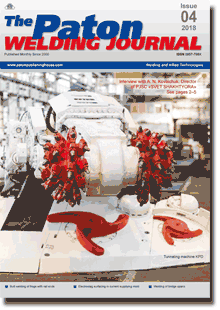| 2018 №04 (06) |
DOI of Article 10.15407/tpwj2018.04.07 |
2018 №04 (08) |

The Paton Welding Journal, 2018, #4, 35-38 pages
Influence of surfacing modes using flux-cored strips on chemical composition and hardness of deposited metal
A.P. Voronchuk, A.P. Zhudra, A.V. Petrov and V.V. Fedosenko
E.O. Paton Electric Welding Institute of the NAS of Ukraine 11 Kazimir Malevich Str., 03150, Kyiv, Ukraine. E-mail: office@paton.kiev.ua
Abstract
The influence of surfacing modes with an open arc using flux-cored strips of different types on chemical composition and hardness of the deposited metal was studied. PL-AN 101 and PL-AN 179 flux-cored strips manufactured on the base of steel strip-sheath, as well as PL-AN 111 strip on the base of nickel sheath were selected as the objects of investigations. Surfacing was performed in A-874N machine with VDU-1201 power source and AD-167 attachment in a wide range of modes. The dependencies of the change of chemical composition of the deposited metal on the value of current, voltage and deposition rate were established. At the same time, change of current values in the range of 600–1100 A has little effect on chemical composition of metal deposited with PL-AN 101 and PL-AN 111 strips, and in surfacing with PL-AN 179 strip it results in increase of the content of almost all alloying elements. Increase of voltage and deposition rate leads to decrease of the degree of alloying for all the types of flux-cored strips and to decrease of deposited metal hardness, and increase of current leads to its growth. 8 Ref., 1 Table, 4 Figures.
Keywords: flux-cored strip, surfacing modes, chemical composition, hardness
Received: 14.02.18
Published: 11.04.18
References
- Zhudra, A.P., Voronchuk, A.P., Kochura, V.O. et al. (2017) Effect of flux-cored strip surfacing modes on geometric parameters of deposited beads. The Paton Welding J., 1, 36–40. https://doi.org/10.15407/tpwj2017.01.06
- Kravtsov, T.G. (1978) Electric arc surfacing with electrode strip. Moscow, Mashinostroenie [in Russian].
- Kudelya, E.S., Subbotovsky, V.P. (1954) Examination of composition and homogeneity of high-alloy deposited metal by spectral method. Svarka, 3, 4–81 [in Russian].
- Frumin, I.I. (1960) Automatic wear-resistant surfacing. Moscow, Mashinostroenie [in Russian].
- Frumin, I.I. (1961) Automatic electric arc surfacing. Kharkov, Metallurgizdat [in Russian].
- Yuzvenko, Yu.A., Gorpenyuk, B.N., Shimanovsky V.P. et al. (1977) Chemical macroheterogeneity of metal deposited by open arc with flux-cored strip. In: Theoretrical and technological principles of surfacing, 21–29 [in Russian].
- Patskevich, I.R., Fejfets, L.A. (1971) About chemical heterogeneity of layer deposited with flux-cored strip in carbon-dioxide gas. Svarka, 11, 66–67 [in Russian].
- Zhudra, A.P., Voronchuk, A.P. (2012) Cladding flux-cored strips (Review). The Paton Welding Journal, 1, 39–44.
